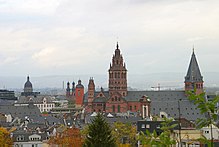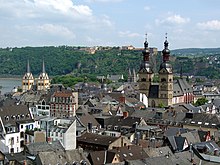Rhineland-Palatinate
Rhineland-Palatinate (German: Rheinland-Pfalz, pronounced [ˈʁaɪ̯nlant ˈp͡falt͡s]) is one of the 16 states (German: Bundesländer) of the Federal Republic of Germany. It has an area of 19,846 square kilometres (7,663 sq mi) and about four million inhabitants. The city of Mainz functions as the state capital.[1]
History
The state of Rhineland-Palatinate was established on 30 August 1946.[1] It was formed from the northern part of the French Occupation Zone, which included parts of Bavaria (the Rhenish Palatinate), the southern parts of the Prussian Rhine Province (including the District of Birkenfeld, which formerly belonged to Oldenburg), parts of the Prussian Province of Nassau (see Hesse-Nassau), and parts of Hesse-Darmstadt (Rhenish Hesse on the western bank of the Rhine[1]). The state constitution was confirmed by referendum on 18 May 1947.
Geography
Located in western Germany, the Rhineland-Palatinate borders (from the north and clockwise) the German Bundesländer North Rhine-Westphalia, Hesse, and Baden-Württemberg. It shares an international border with France, followed by another Bundesland, Saarland, and international borders with Luxembourg and Belgium.
The largest river in the state is the Rhine, which forms the border with Baden-Württemberg and Hesse in the southeast before flowing through the northern part of Rhineland-Palatinate. The Rhine Valley is bounded by mountain chains and it contains several of the historically significant places in Germany.
The Eifel and Hunsrück mountain chains are found on the west bank of the Rhine in northern Rhineland-Palatinate, while the Westerwald and Taunus mountains are found on the east bank. The hilly lands in the southernmost region of the state are covered by the Palatinate forest and the Palatinate. These mountain chains are separated from each other by several tributaries of the Rhine: the Mosel, the Lahn, and the Nahe.
The modern state consists of a conglomeration of the historic regions of southern Rhine Province, Rheinhessen, and the Palatinate.
See also List of places in Rhineland-Palatinate and List of landscapes in Rhineland-Palatinate.
Administration




Rhineland-Palatinate is divided into 24 districts, formerly grouped into the three administrative regions: Koblenz, Trier and Rheinhessen-Pfalz.
Since 2000, the employees and assets of the former administrative regions have been organized into the Aufsichts- und Dienstleistungsdirektion Trier (Supervisory and Service Directorate Trier) and the Struktur- und Genehmigungsdirektionen (Structural and Approval Directorates) Nord in Koblenz and Süd in Neustadt (Weinstraße). These administrations execute their authority over the whole state, for example, the ADD Trier oversees all schools.

Map of the districts of Rhineland-Palatinate:
 Ahrweiler
Ahrweiler Altenkirchen
Altenkirchen Alzey-Worms
Alzey-Worms Bad Dürkheim
Bad Dürkheim Bad Kreuznach
Bad Kreuznach Bernkastel-Wittlich
Bernkastel-Wittlich Birkenfeld
Birkenfeld Bitburg-Prüm
Bitburg-Prüm Cochem-Zell
Cochem-Zell Vulkaneifel
Vulkaneifel Donnersbergkreis
Donnersbergkreis Germersheim
Germersheim Kaiserslautern
Kaiserslautern Kusel
Kusel Rhein-Pfalz-Kreis
Rhein-Pfalz-Kreis Mainz-Bingen
Mainz-Bingen Mayen-Koblenz
Mayen-Koblenz Neuwied
Neuwied Rhein-Hunsrück
Rhein-Hunsrück Rhein-Lahn
Rhein-Lahn Südliche Weinstraße
Südliche Weinstraße Südwestpfalz
Südwestpfalz Trier-Saarburg
Trier-Saarburg Westerwaldkreis
Westerwaldkreis
Every district is composed of numerous municipalities, which can consist of cities, villages, or groups of villages known as Verbandsgemeinden. There are also twelve urban districts that are identified on the map with letters:
 Frankenthal (F)
Frankenthal (F) Kaiserslautern (Ka)
Kaiserslautern (Ka) Koblenz Coblenz (Ko)
Koblenz Coblenz (Ko) Landau (La, the main city and an exclave)
Landau (La, the main city and an exclave) Ludwigshafen (Rheinpfalz-Kreis) (L)
Ludwigshafen (Rheinpfalz-Kreis) (L) Mainz (M)
Mainz (M) Neustadt (Weinstraße) (N)
Neustadt (Weinstraße) (N) Pirmasens (P)
Pirmasens (P) Speyer Spires (S)
Speyer Spires (S) Trier (T)
Trier (T) Worms (W)
Worms (W) Zweibrücken (Z)
Zweibrücken (Z)
Demographics
| Significant foreign born populations[2] | |
| Nationality | Population (2014) |
|---|---|
| 60,159 | |
| 36,817 | |
| 28,538 | |
| 15,805 | |
| 10,926 | |
| 9,503 | |
Religion
As of 2010 44.9% of the population of the state adhered to the Roman Catholic Church, 30.6% to the Evangelical Church in Germany.[3] 22.0% of the population is irreligious or adheres to other religions. Muslims made up 2.5% of the total.[4]
Jewish culture
The league of ShUM-cities in the later Rhineland-Palatinate comprised the Jewish communities of Mainz, Speyer and Worms which became the center of Jewish life during Medieval times. The Takkanot Shum (Template:Lang-he), or Enactments of ShU"M were a set of decrees formulated and agreed upon over a period of decades by their Jewish community leaders.
Politics

State elections
Elections for the Rhineland-Palatinate Landtag are held every five years, with residents over age 18 eligible to vote. This regional parliament or legislature then elects the premier and confirms the cabinet members. Rhineland-Palatinate is the only German state to have a cabinet minister for winegrowing (Ministry of Economy, Traffic, Agriculture and Winegrowing)
Latest state election
Template:Rhineland-Palatinate state election, 2011
Economy
Industry
Rhineland-Palatinate leads all German states with an export rate of approximately 50%.[1] Important sectors are the winegrowing industry, chemical industry, pharmaceutical industry and auto parts industry.[1] "Distinctive regional industries" includes gemstone industry, ceramic and glass industry and leather industry. Small and medium enterprises are considered the "backbone" of the economy in Rhineland-Palatinate.[1] The principal employer is the chemical and plastics processing industry which is represented by BASF in Ludwigshafen. Boehringer, Joh. A. Benckiser, SGE Deutsche Holding, Schott Glassworks concludes the top 5 companies in the state.[1]
Agriculture and viticulture
Rhineland-Palatinate is Germany's leading producer of wine in terms of grape cultivation and wine export. Its capital, Mainz, may be called the capital of the German wine industry, being the home of the German Wine Institute, the German Wine Fund in the Haus des Deutschen Weines (House of German Wine), and the Verband Deutscher Prädikats- und Qualitätsweingüter Wine Bourse, which brings together the top winemakers of Germany and the wine merchants of the world.
Of thirteen wine regions producing quality wine in Germany, six (Rheinhessen, Pfalz, Mosel, Nahe, Mittelrhein and Ahr) are located in Rhineland-Palatinate, with 65% to 70% of the production of wine grapes in Germany having their origin within the state. 13,000 wine producers generate 80% to 90% of the German wine export, which was 2.6 million hectoliters in 2003.[citation needed]
Traditional grape varieties and a wide range of varieties developed during the last 125 years are characteristic for the region.
Classical white varieties are cultivated at 63,683 hectares (157,360 acres). These comprise the famous Rieslings 14,446 hectares (35,700 acres), Müller-Thurgau (8,663 hectares (21,410 acres)), Silvaner (3,701 hectares (9,150 acres)) and Kerner (3,399 hectares (8,400 acres)).
The share of red varieties grew constantly during the last decades and amounts to 20,000 hectares (49,000 acres). Dornfelder, a new cultivar, is the leading red grape cultivated on 7,626 hectares (18,840 acres), which is more than a third. Blauer Portugieser (4,446 hectares (10,990 acres)) and Spätburgunder (3,867 hectares (9,560 acres)) show also appreciable cultivated shares.[5]
In addition, Pinot blanc, Pinot gris, Chardonnay as white varieties and Regent and St. Laurent as red varieties have been increasing their share, as the growing conditions improve in Rhineland-Palatinate.
The state supports the wine industry by providing a comprehensive consultancy and education program in the service supply centers (German: DLR) of the land. The Geilweilerhof Institute for Grape Breeding is fully financed by the state. Many well known new breeds, such as Morio-Muskat, Bacchus, Optima and Regent have been created in these institutes.
The world-wide leader in sparkling wine production, producing 245 million bottles in 2006, is the renowned Schloss Wachenheim Group. This company is headquartered in Trier, with operations in several locations in Rhineland-Palatinate.[6]
Other renowned sparkling wine producers, such as Kupferberg, Deinhard and Henkell, also had their roots in the region, but now belong to companies outside the state as a result of business consolidation.
Emigration
Rhineland-Palatinate has supplied immigrants to many parts of the world. The names of the villages of New Paltz, Palatine Bridge and German Flatts, New York, and Palatine, Illinois, attest to settlements of Palatine Germans. The Hunsrückischen dialect in Brazil also bears testimony to an immigrant community.
The Pennsylvania Dutch spoken by the Amish in the United States is (among other dialects) derived from the German dialect spoken in the Rhineland-Palatinate, which many Palatine refugees brought to the colony in the early decades of the 18th century. The only existing Pennsylvania German newspaper, Hiwwe wie Driwwe, is published bi-annually in the village Ober-Olm, which is located close to Mainz, the state capital. In the same village, one can find the headquarters of the German-Pennsylvanian Association.
Certain colonies in the United States were settled by major groups of poor Palatines—then refugees in England—passage paid for by Queen Anne to reduce the number of impoverished families who had taken refuge in London. In 1710 the English used ten ships to transport nearly 3,000 Germans to the colony of New York. Many died en route, as they had been weakened by disease. They were settled in work camps along the Hudson River, where they developed naval stores for the English to work off their passage. Churches set up in both the East and West Camps provided some of the earliest population records in New York. In 1723 the first hundred heads of families were allowed to acquire land west of Little Falls, New York, along the Mohawk River, in what was called the Burnetsfield Patent after the governor. This became Herkimer County. The Germans and their descendants were important in the defense of the Mohawk Valley during the American Revolutionary War.
New Bern is one of the earliest North Carolina colonies settled in 1710 by about 400 Palatines (650 left Germany, but about half died in passage) and 100 Swiss. This venture was orchestrated by the Swiss-born Christoph von Graffenried after purchasing more than 19,000 acres (7,700 ha) from the British Proprietors of the Carolinas.
In the 19th century, there was a substantial number of emigrants from the area around Trier, many of whom settled in Wisconsin.
See also
Literature
- Kreuz – Rad – Löwe. Rheinland-Pfalz und seine Geschichte; Verlag Philipp von Zabern, Mainz 2012
- Band 1 (Von den Anfängen der Erdgeschichte bis zum Ende des Alten Reiches): ISBN 9783805345101
- Bände 2 (Vom ausgehenden 18. Jahrhundert bis ins 21. Jahrhundert) und 3 (Historische Statistik): ISBN 9783805342919
References
- ^ a b c d e f g "State Facts of Rhineland-Palatinate". State of Rhineland-Palatinate. Retrieved 26 September 2011.
- ^ [1] 31 Dec. 2014 German Statistical Office. Zensus 2014: Bevölkerung am 31. Dezember 2014
- ^ "Statistik der EKD, Stand 31. Dezember 2010" (PDF). Retrieved 2012-10-29.
- ^ "3. Zuwanderungs- und Integrationsbericht der Landesregierung (2008)". Integration.rlp.de. Retrieved 2012-10-29.
- ^ Cultivated grape varieties in Rhineland-Palatinate 2005 publisher: Statistical Office of Rhineland-Palatinate
- ^ annual report Schloss-Wachenheim Group 2005/2006 publisher: Schloss-Wachenheim Group
External links
- Official governmental portal
 Geographic data related to Rhineland-Palatinate at OpenStreetMap
Geographic data related to Rhineland-Palatinate at OpenStreetMap


